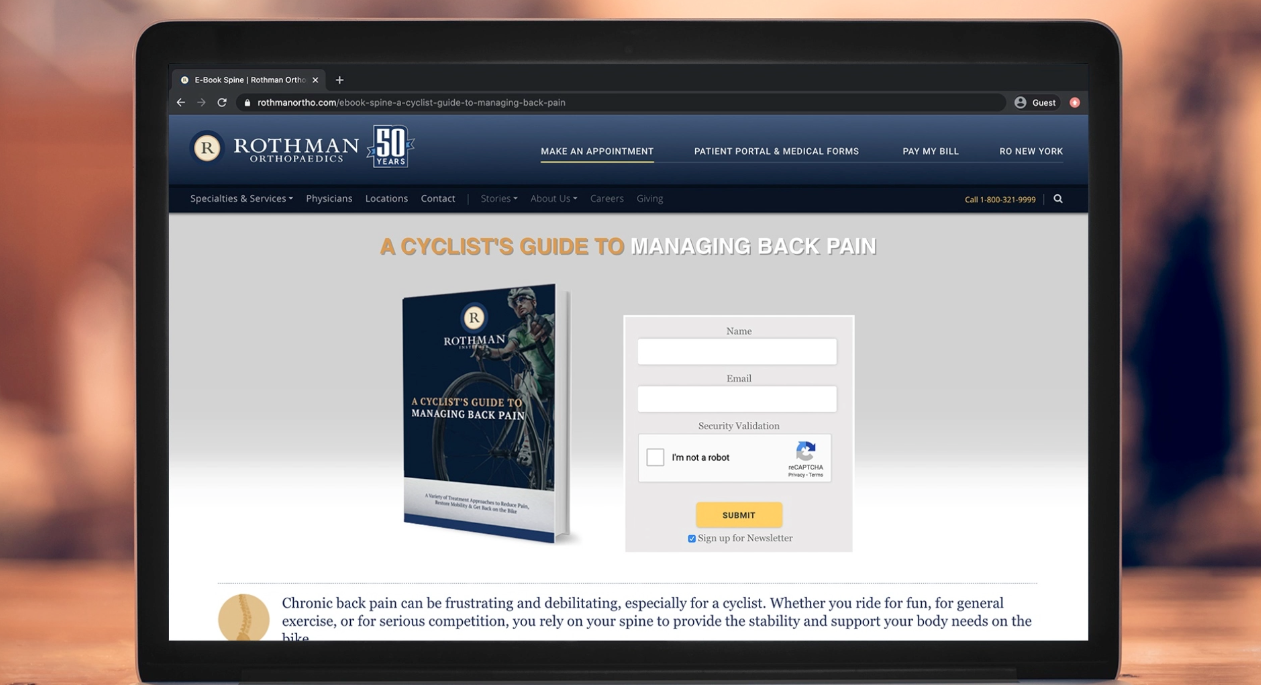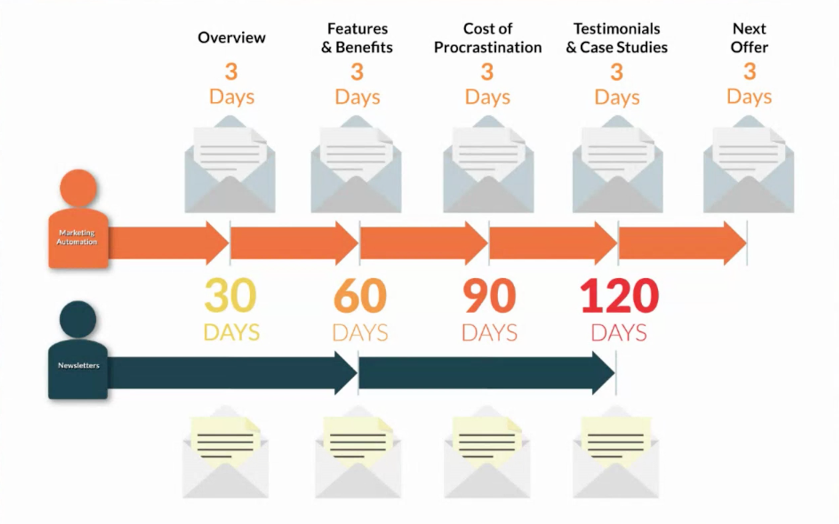How to Create a Digital Content Strategy in 4 Simple Steps
Unpacking a Killer Digital Content Marketing Strategy
When it’s done right, content marketing is an excellent way to build brand awareness, grow your client list, and drive traffic to your products and services. We get asked all the time to break down the essential elements of an effective digital content strategy.
So, we figured…why not do that right here?
In the information below, you’ll find a no-nonsense overview of what we believe are the four most important parts of a digital content marketing strategy. Plus, we’ll even throw in a bonus tip for you at the end.
Like we always say about marketing, it’s best to focus on building systems, rather than individual solutions. As you read, remember that these four steps are part of a bigger, comprehensive marketing approach.
Hub & Spoke: Creating Content Families
Back in the day, Google’s algorithms were set up to reward single pieces of quality content to rank for individual keywords. Marketers went crazy creating content mills to mass-produce individual (and often very generic) pieces of content.
However, Google quickly updated their game and created more sophisticated, nuanced algorithms that now essentially reward thought leaders.
In other words, search engines now look for sites that have a broad range of helpful content on a variety of similar keywords, covering a particular subject. It’s really not possible anymore to rank with a one-hit-wonder.

Here’s how to build a digital content strategy with an emphasis on “families” of pages around similar to
pics.
Hub Pages
A longer piece of content that summarizes information about your main keywords. *Note: these are sometimes referred to as pillar pages.
Spoke Pages
These are shorter pages focused around related or more specific long tail keywords that can support and point to your major hub page for that topic
This kind of content strategy is better for Google, your audience, and you. Now, rather than getting a single piece of content to rank, if you build these “families of pages” correctly, you’ll get multiple pages ranking and improved domain authority for your entire site. When it’s properly done, this is how content marketing can save your digital marketing strategy.
Tip: Keep in mind, organizing a plan for these kinds of “content families” is a daunting task without an editorial calendar. You’ve got to be able to plan out ahead of time. Optimally, a three to six-month digital content plan is best to plot out keywords.
Being organized with your editorial calendar will help get you better results. In fact, according to data reported by CoSchedule, marketers who proactively plan projects are 356% more likely to report success!
365%!
Marketing Automation is a Must-Have
There are so many upsides to using marketing automation, it’s ridiculous.
Automation was designed to do the things we don’t have time to do or that we often forget to do. For a while, marketing automation was a “nice-to-have” option. But, in today’s fast-paced world of modern marketing, it’s a must-have.
In fact, HubSpot reported that the anticipated year-over-year growth for marketing automation platforms is 31%.
There are a few different aspects of creating a solid marketing automation system, starting with:
Lead Nurturing
This all starts with tracking. The first priority is collecting your prospect’s contact information and dropping a cookie on their computer. This enables you to start communicating with them regularly with strategic messaging, including:
- Overview
- Features & benefits
- Cost of procrastination
- Testimonials
- Case studies
- New offers
- Newsletter
Communicating with your prospect in this way is known as lead nurturing. Another important aspect of this process is lead scoring.
Lead Scoring
Now it’s time to monitor prospect engagement with your brand and assign each person a lead score. That score will be based on how many emails they open, how often they return to your site, what kinds of pages they read, and what content they download.
The lead score is precious intelligence for your sales team. It’s going to give them the details they need to identify and quickly close the leads that are ready to buy (and continue to nurture those who are still in the awareness phase).

But, we want to take this a step further. We want to also identify and reduce slippage.
Slippage
You know the feeling when after the best sales call of your life, your potential client just seems to fall off the face of the earth? Wouldn’t it be fantastic if there was a go-to plan when a prospect institutes ghost protocol?
There is actually.
You can use specific email marketing automation to “drip” messaging to them that will re-engage them in the sales cycle.
At the place where a lead starts to “slip” off the hook, you need to create strategic content to reinforce what they liked and address their concerns. These emails, which respond to their objections, should go out in an orderly timeline as a function of your sales cycle.
Developing Offer Content That Converts
When considering how to create digital content marketing strategy pieces, you can’t forget offer development! We like to refer to offers as “content upgrades” because this communicates the value of this specific type of content.
So, the essential question to answer here is:
What kind of content will bring value?
The gated content itself has to be worth it for a prospect to want to trade their contact info to get it. If you can’t bring value, you’re probably not going to get many downloads or cookies on people’s computers.
The best ways to create an offer that will convert:
- Include information that’s data-packed
- Connect your offer with a utility (ie: a calculator, grader, or other some sort of interactive tool)
- Create offers that are specific to certain buyer personas or audience “verticals”

Not only does your offer have to be quality, the landing page it’s sitting on has to be on point too. Your offer is going to live or die on your landing page.
The best ways to create a landing page that will convert:
- Focus on benefits (what this offer will do for you)
- Keep the content on the page brief (QWASI = Questions With Answers And Simple Information)
- Include a video if possible
Let’s Talk About That Blog
When it comes to blogging, there’s one thing we need to say upfront. If you’re not planning to keep your blog up to date, don’t even bother creating one.
Yeah, we’re serious. Google is looking for companies that publish quality content, consistently. And there are people out there doing it, so you have to be committed to compete. WordPress reported that as of this year, its users produce about 70 million new posts and 77 million new comments each month!

One Extra Tip: Harness the Power of a Well-Told Story
There’s a reason that Disney is a multi-billion dollar company. It’s because the people who can tell the best stories win. The power of a solid story arc is that it connects to the reader on a very personal, relatable, and even emotional level.
Every good “story”—even marketing messages—should include four important aspects to complete a story arc that draws the reader in and leaves them better off than they were when they started reading.
Good Content Include These 4 Parts: PPPO
Pain: Here’s where you empathize with your particular audience (make sure you can verbalize this using the terms and buzzwords that are the same ones they’re using inside their head).
Promise: Clearly identify the problem they’re facing and explain how you’re ready to solve that problem and get them where you want to go. Then describe how.
Proof: You need your reader to know that this is not your first rodeo. Showcase studies, testimonials, success stories, and data.
Opportunity: Give your reader the next step that makes the most sense for where they are in their buyer’s journey. (Hint: don’t ask them to marry you after the first date.)
This might sound overwhelming, but don’t get discouraged. Maybe you feel like you’re already drowning under the pile of marketing tasks you’d like to get to, but never can. How in the world would you add regular blog writing and publishing on top of all that?
We get it. Our best advice is to use an editorial calendar, set up a user-friendly CMS, and get some help with managing your digital content strategy.
Your editorial calendar is your game plan for content development, and you’ve got to live and die by it. Unless of course, you have a really sophisticated in-house team managing all of this. Otherwise, this amount of effort and complexity commonly requires working with a marketing agency.
Interested in getting some help creating and implementing an editorial calendar and marketing automation to produce, publish, and follow up with every blog, hub, spoke, and offer? Contact us to request a free consultation.
We’d love to help your business learn how to create a digital content marketing strategy to fit your budget and achieve your goals!

